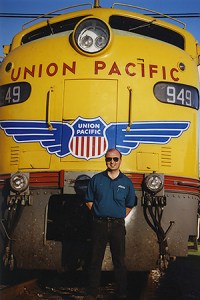Just Another Missouri Pacific Geep – Not!

Missouri Pacific GP7 1760 lays over next to the MP's Mission, Texas yard office on Feb. 14, 1980. (Click image to better view the details)
Don’t be fooled by the utilitarian appearance and MP freight colors on MP GP7 1760. It looks like any other MP Geep of the era, but a closer look reveals its heritage as a passenger locomotive.
Note the rooftop air tanks and dual gauges (just forward, and above the trailing truck).
Dual gauges: passenger service Geeps were built with steam generators to provide heat and hot water for the passenger cars. This required enlarging and splitting the fuel tank into two reservoirs, one for fuel and the other for water for the steam generator. That is why you see 2 gauges.
Rooftop air tanks: placing the air tanks on the roof increased the amount of room available under the frame, increasing the capacity of the fuel/water tank.
Missouri Pacific took delivery of GP7 4241 in mid-1952. It was re-numbered 309 before becoming 1760 in the 1975 system re-numbering. In the early 1970’s, the MP cut down the high short hood of many of its GP7’s.
Here’s a picture of a sister unit in passenger service, showing the original high short hood. Note the rounded steam generator exhaust vent just forward of the cab roof.

Missouri Pacific passenger service GP7 322, date and location unknown.
The 1760, and all of the MP’s early Geeps, were retired by 1981. They were used as trade-ins for the MP’s GP15-1 and GP38-2 orders of 1980 – 1981.
If I’m not mistaken, the MP was the first major railroad to retire its GP7’s and GP9’s.

Great shot. Always good to see more stuff from the Valley. Did the road freights down there usually get teams of GP’s like this one or did they get SD40’s? By the time I first got down there, the merger had already occurred, and UP used SD40’s on all the road freights.
Kingsville to Harlingen was literally anything — GP7’s to SD40-2’s and U30C’s.
Harlingen to Brownsville & to McAllen was all 4-axle, mostly older Geeps, but toward my departure from the valley, GP15-1’s and GP38-2’s were starting to displace the older Geeps. Strangest catch was a MP U23B in McAllen on the local.
Have you seen all of the MP stuff I’ve posted? If not, do a search under the MP category in the right sidebar.
I started my railroad career in Kingsville in 1970. One of my first assignments out of town was Mission. I worked the local that ran daily between Mission and Rio Grande City. As you said, we usually had a GP18 or Gp7. During that period I came in one morning and a GP28 lettered for KO&G was sitting their. I was excited all day with the shiny blue engine, but the new was worn off after working 12 hrs. Thanks for the pictures.
I worked for the good. Ole MOP for 15 years or so as locomotive engineer, boy how I miss the days of the old Geeps, GP-7 & GP-9’s the old long nose, just did not like the to much cause I couldn’t see, it rattled so much, the was nasty loud. I broke in on the old A-units at times, that was fun. Got to run the GP-38’s and the Cadillac in my day the SD-40, 3000 horses, loved it. Especially out of Kingsville on 194, the chemical train in those days.
Anyway I got to work with some great Larry Shevelbein, I know I spelled his last name wrong, but what a friend and great Engineer, we worked opposite of each other on the middle division inn Kingsville, Tx. Great guy.
Brady Parker
Thanks for posting the photo of GP7 #1760. It helped me identify a photo of her sister #1761 that I took from the cab of GP18 #1941 on a run from Houston to Vanderbilt around 1982 (but if the retirement age Robert mentions is correct, then my photo is from 1980 or 1981). In the angle I shot, I could only make out the last two digits of the locomotive number on the long hood plus a torpedo tube on the roof.
I remember the yard office at Mission. I think it had mainly a bench and a table with a printer inside, so the conductor could print out our work every day. I worked the Mission TSE as a brakeman on several occasions when I was forced down to Kingsville. One Saturday we went to Rio Grande City with only a carload of lumber. Those 33 miles one-way plus lunch took us about seven hours at 10 mph. The last time I worked the Mission job was about one or two weeks before the Mop sold the Mission–Rio Grande City portion to the Border Pacific, and the crew was rather dejectedly talking about the job getting pulled off at that point. After the job was pulled off, they ran a TSE from Harlingen to Mission every day to handle the local work. Now Harlingen–Mission is Rio Valley Switching, I believe.
David: I emailed you a photo containing the #1761 several weeks ago.
Robert: I’m the guy for which you did the clinic for the San Jacinto Model Railroad Club a few years back.
Hi David,
Of course I remember you. I enjoy reading your accounts of working on the MoP back in the day…